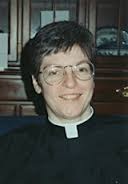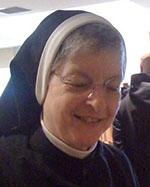 In 1970, the Episcopal General Convention authorized diaconal ordination for women, a non-sacerdotal role. Two years later, Bishop Paul Moore, Jr., of the Episcopal Diocese of New York, interviewed Ellen Marie Barrett, an early female candidate for ordination to the diaconate.
In 1970, the Episcopal General Convention authorized diaconal ordination for women, a non-sacerdotal role. Two years later, Bishop Paul Moore, Jr., of the Episcopal Diocese of New York, interviewed Ellen Marie Barrett, an early female candidate for ordination to the diaconate.
I asked her to sit down on the sofa across from the wing chair where I usually sit when someone comes to see me. Ellen is tall, with dark brown hair conservatively styled. She, like many tall people, stoops a little as she walks. Her most arresting feature is her eyes, which appear honest, deep, and welcoming … In conversation, she seems rather soft, until the discussion finds its way into an area of faith or conviction. Then you strike rock.
Though the progressive bishop was impressed with Barrett, he did not recommend her for ordination to the diaconate because she was an out lesbian. Barrett attended seminary. When she finished in 1975, she again asked Bishop Moore to approve her for ordination to the diaconate. He relented, and she was ordained a deacon in December, 1975 before a few church ladies, a few students, and her proud Southern mother. The ordination barely disturbed the church mice even though Barrett had been elected co-president of Integrity, an Episcopal LGBT advocacy group, at its inaugural national meeting earlier that year.
The following summer, the Episcopal General Convention went further; church canons were revised to allow women to be ordained to the priesthood, and many lined up for ordination when the policy would become effective in January, 1977. Deacon Barrett was among the hopeful women, but she and Bishop Moore weren’t prepared for the firestorm that awaited them. TV networks were there for her January ordination, which was a Time Magazine feature story.
The bishop and the lesbian priest were hounded mercilessly with calls, letters, and rejection. The last years of the decade of the seventies degenerated into the “height of homophobia” within the Episcopal Church. Barrett didn’t have a comfortable career and faced crushing depression. Eventually, she joined the Order of St. Benedict as Sister Bernadette.
 In researching her story, I located her in the Diocese of Newark, and I asked her to comment. Months passed, and I heard nothing. Then, a long email arrived. With Sister Bernadette’s permission, the entire email appears as a poignant coda to the Episcopal section of my book.
In researching her story, I located her in the Diocese of Newark, and I asked her to comment. Months passed, and I heard nothing. Then, a long email arrived. With Sister Bernadette’s permission, the entire email appears as a poignant coda to the Episcopal section of my book.
Here’s a snippet:
Would I do it again? Knowing what I know now? That’s not a question that can possibly have an answer. Today is a very different time. I have no idea whether God would have moulded my combination of weakness, pig-headedness, and some talent into what another time would need. I was what I was, and I did what I did, in the context of a particular time and socio-political climate.
Am I still convinced it was the right thing to do? Yes. Done the right way by the right person? Who knows? It is what it is. And priesthood is as much a part of me as green eyes and once black hair turning white.
I am a priest forever. That’s all.
This is the fourth installment in the series Cast of characters countdown. I will continue to post biographical notes about the iconic pilgrims and prophets on the road to full inclusion who are featured prominently in Queer Clergy. Here’s the list of prior posts:
1968 Troy Perry (founder of the MCC)
1970 Robert Mary Clement (gay priest who marched in the first Gay Pride parade)
1970 William Johnson (first out gay man to be ordained by a traditional denomination)
1972 Ellen Marie Barrett (first out lesbian ordained to the Episcopal priesthood)
1974 James Siefkes (Lutheran pastor behind the formation of Lutherans Concerned)
1974 David Bailey Sindt (founder of More Light Presbyterians)
